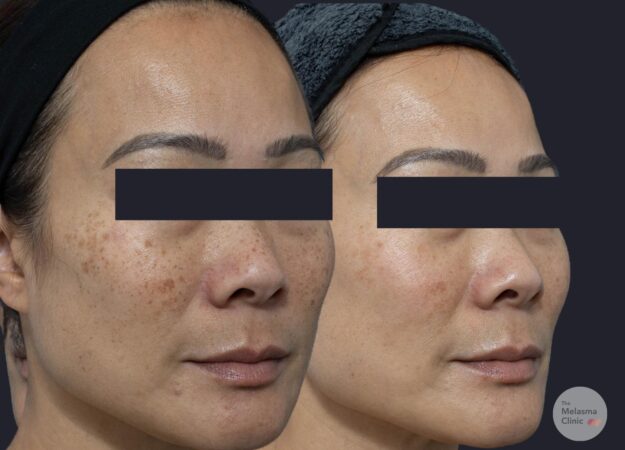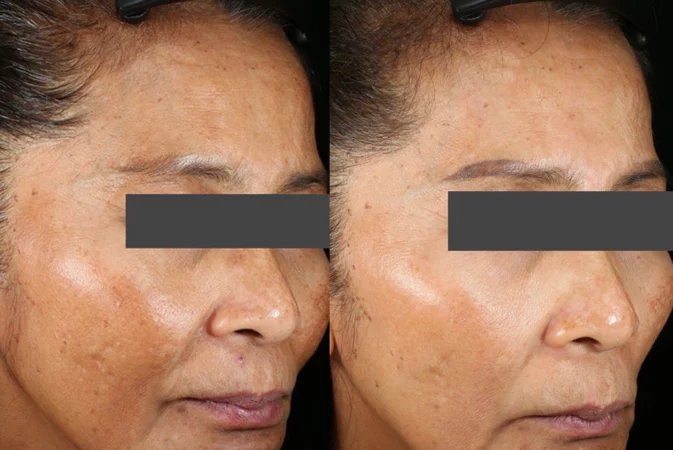Pigment lasers are excellent ways to reduce melasma pigmentation. Using specific parameters, dermatologists can effectively & safely treat melasma in over 90% of cases. Our dermatologists at Cutis have over 20 years of clinical experience in the management of pigmentation.
关键点
- Lasers are one of the most effective ways to treat melasma pigmentation
- At Cutis, we match an optimal laser system with your specific melasma pattern
- Pico lasers including Picoway & Picosure Pro are useful treatments for resistant pigment
- Medical therapy is always first line treatment
- Fractional lasers are used as last line treatment
- Vascular lasers can be marginally effective
Melasma Lasers at a glance
我们的结果不言自明

Before
After

Before
After

Pico lasers provides fast removal of pigment with minimal downtime.
向我们询问更多关于该疗法的信息

Before
After
常见问题
What can lasers do for melasma?
Lasers can safely reduce pigmentation, even out skin tone, diminish fine lines & provide better light transmission & luminosity.
Melasma lasers have the highest efficacy in the treatment of melasma & are used as adjunctive therapy with clinical grade pigment correctors.
How do they work?
Laser work by reducing pigment output from pigment producing cells known as melanocytes. This is an important concept to understand in the context of melasma treatment.
Lasers can also destroy pigment particles (not a great idea in melasma). We have other lasers that can push pigment out (fractional lasers), lasers that repair damaged basement membranes (fractional lasers) & lasers that reduce vessel input to pigment cells.
Pico lasers also release growth factors that can modulate vessels & re-establish barrier function to reduce pigment drop out in the deeper layers. They can also reduce pigment whilst minimizing heat transfer to the skin.
How soon will I notice the results?
Results can be seen as early as two weeks but are maximal at 10-16 weeks. This is because it takes time to reduce pigment output, but at the same time mitigate the risks of stimulating more pigment. It is a fine balance when treating melasma.
What lasers do we have at Cutis?
In order of use (in the context of melasma), we employ the following lasers-
- 光谱,帕斯泰尔
- Picoway, Picosure Pro
- Fraxel 1927, C+B diode 1927, Frax Pro, LaseMD ultra
- 分数NA 1550
- 血管激光器-532 DermaV, 595 Prima, 595 Perfecta
Melasma laser selection is based upon clinical & historical findings. This means we match a treatment laser upon your pattern of melasma.
How do I know what lasers are best for my melasma?
Book a FREE consultation with our nurses. They are one of Australia’s most experienced clinicians.
*Consult fee redeemable with procedures.
Can melasma in all skin types be treated with lasers?
Yes. Cutis Dermatology has specific lasers for treating darker – ethnic skin types, including the best pico lasers on the market- Picoway & Picosure Pro.
What should you consider before undertaking melasma laser treatments?
Treating melasma is an investment of time, effort, & money for patients. Here are some helpful points that may help you along your journey.
- Equipment & settings are critical. Pico lasers are not the answer to melasma pigmentation. They are useful as adjunctive therapy in resistant cases.
- Consider your options: lasers, used correctly, are inherently safer, better & cost less than chemical peels.
- Depth of pigment. Is your provider sure of the depth of pigmentation? This is especially important to gauge success.
- 后续行动:黄褐斑反复发作。您的护肤品提供商是否制定了保养计划?
- Motivation: The most important aspect of melasma treatment is sun protection, so you MUST be super motivated to take this first step.
- 防晒至关重要.无论暴露于何种环境,每天两次 SPF 50+ 防晒霜。如果一瓶 50 毫升的防晒霜使用时间超过 3 周,说明您使用的防晒霜不够。
For more information on treating melasma book a *FREE consultation with our laser nurses.
For complex cases, book a consultation with our specialist dermatologists, fees apply.
*Fee refunded with procedural treatments.
产品

O Cosmedics cleansing range
$63.00-$64.00

O Biotics 3D Hyaluronic Serum
From $97.00
Using specific parameters, dermatologists can effectively & safely treat melasma in over 90% of cases.
Why is medical therapy indicated as first line treatment for melasma?
Effective melasma therapy entails treating the cause/s. Dermatologist address-
- Pigment over production with tyrosinase enzyme inhibitors in specific concentrations. The corrector of choice depends on depth of pigment, your skin type, & skin sensitivity.
- Vasculature involvement: using specific modulators we can reduce vessel in put to your pigment cells/melanocytes.
- Visible light, UVA, UVB & IR radiation: Correct sunscreens will reduce the input of radiation.
Is Pico the best laser for melasma?
No. At Cutis Dermatology we run both the Picoway & Picosure Pro. These lasers are great at treating pigmentation from inflammation, age & UV, however they are not first line lasers for the treatment of melasma.
Picoway & Picosure lasers are used to treat-
- Recalcitrant & resistant dermal melasma
- Melasma with age & sun induced pigment
- Mandibular melasma
- Post inflammatory hyperpigmentation & rebound melasma from other devices
Can Fraxel treat melasma?
Fraxel was the first laser to be approved for melasma in 2006, we now know that this is not a good treatment option for melasma pigment, however it is an excellent treatment for sun induced pigmentation.
Dermatologists employ Fraxel Dual 1550 as last line treatment for melasma. It works by pigment exfoliation, rather than addressing the pigment producing cells.
Why did my melasma flare up after laser treatment?
Settings, techniques & laser wavelengths are vital in treating melasma effectively & safely. We use specific settings to reduce pigment production using our pigment lasers.
Can IPL or BBL treat melasma?
BBL including the new BBL Hero is great for non-melasma pigmentation. This treatment can, & usually does flare up melasma. It is because the heat generated from BBL stimulates the pigment cells to produce more melanin.
With BBL treatment, patients will usually get a good reduction of pigment in the first two weeks, as pigment is shed from the upper layers of skin. Rebound occurs at week 3-4.
Who do lasers compare to peels for melasma?
Dermatologists prefer lasers as they are inherently safer, more predictable & cost less. Peels, including Dermamelan, Cosmelan & Melapeels are useful for fast results, at the expense of higher costs, risks & downtime.
Peels are useful for out-of-town patients, & for superficial pigment. They have a dismal clearance rate for deeper pigment.
| 激光器 | 没有停机时间 | 低至无风险 | 缓慢而稳定的结果 | 低成本 |
| Cosmelan剥皮 | 3-7天的停工期 | 中等风险 | 快速的结果 | 高成本 |
| Dermamelan剥皮 | 4-8天以上的停机时间 | 风险较高 | 快速的结果 | 更高的成本 |
What is the go with yellow light lasers for melasma?
Over the past 5 years, yellow light & vascular lasers have been proposed as a treatment for melasma. They work on the premise of reducing microscopic blood vessels that feed pigment cells.
In rare (<5%) of cases we use these lasers to reduce background redness, however these are adjunctive & not primary lasers.
How can lasers deliver topical tranexamic acid into the skin?
Non-ablative fractional lasers including 1927 Fraxel, Frax Pro, & LaseMD Ultra have all been shown to reduce pigmentation. They can (in theory) work by –
- Re-establishing the barrier between the dermis & the upper layer of skin. This reduces dermal pigment drop out.
- Aid in delivery of tranexamic acid & other compounds in the dermis.
- Have collateral effects on the vasculature, in turn reducing pigment.
- Have other effects that we don’t understand.
Cutis was involved in international trials using the above lasers in 2019-2021. Results have been disappointing, however we do use these lasers as second line therapy, after specific pigment lasers.




